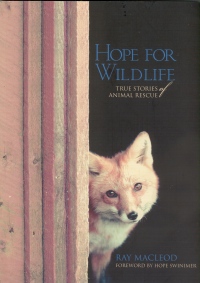| ________________
CM . . .
. Volume XVIII Number 1. . . .September 2, 2011 
 |
Hope for Wildlife: True Stories of Animal Rescue.
Ray MacLeod.
Halifax, NS: Nimbus, 2011.
167 pp., pbk., $19.95.
ISBN 978-1-55109-817-3.
Subject Headings:
Hope for Wildlife Society.
Wildlife rescue-Nova Scotia
Animal rescue-Nova Scotia.
Grades 5-9 / Ages 10-14.
Review by Gillian Richardson.
***1/2 /4
|
| |
|

excerpt:
Of all the birds of prey at Hope for Wildlife that summer, the fire for freedom seemed to burn hottest in Marlene. Of course, no one really knew why. Most said it was simply the natural instinct of a predator to be free. However, a few wondered if there was a nest that had been left unattended that May. Or whether a mate still looked for her. Eagles bond for life and will only take a new partner if the old one dies, and since Marlene was a full adult, at least five years old, she likely had a mate. Was she desperate to tell him she was still alive? She escaped twice in her third month, both times before success was physically possible. The first attempt came when she was still being held in a small isolation cage. No one knows how she got out. The best guess is that the cage was not properly closed. Whatever the cause, she didn't hesitate. A group of Hope for Wildlife workers enjoying a mid-summer lunch at a picnic table next to the barn suddenly realized there was an eagle standing between them and the lake, eyeing them warily.
For anyone concerned about the fate of injured or orphaned wildlife, these stories about the vision, establishment and operation of the Nova Scotia rehabilitation centre, Hope for Wildlife, will make informative and entertaining reading. While drawing inspiration from the experiences with animals in her care, Director Hope Swinimer also hopes to "connect people to wildlife in a positive way through knowledge and understanding." As with other similar centres across Canada, this one depends largely on the dedication and generosity of a volunteer staff, including the help of veterinarians who donate time and expertise to repair damage. In this book, readers will meet and get to know 14 of the thousands of animals who have passed through Hope for Wildlife since its founding in 1997.
Author Ray MacLeod profiles the people involved in this operation as much as the animals themselves. Their stories are interwoven, and what emerges is a picture of willingness to learn, led, of course, by the needs of the animals in their care. While the primary objective of such a facility is to rehabilitate and release, sometimes the latter goal is not straightforward. Not every animal survives its injuries. Once past that hurdle, a major concern is how to teach a young animal the skills it would normally learn from its parents in the wild while minimizing the risks of imprinting on humans that could later endanger it. One solution has been to practice the 'soft release' in which the animal, once healed, is given "the option to come and go as it pleases." This approach resulted in interesting and educational long-term encounters with River, the otter. In other cases, if an animal is not releasable since it would struggle to survive in the wild—a de-scented skunk, a rare bald raccoon, a three-legged fox—it may be kept to provide educational opportunities for the public. In one such case, the centre was engaged in protracted negotiations with government over keeping an endangered pine marten obtained from a former captive breeding-release program that had switched to fur farming.
The writing is lively and engaging in style, rich in fact (text boxes add extra detail about each species), sensory detail and gentle humor, and personalized with many quotes that show the passion that attests to the staff's motivation. The dramatic rescue stories evoke emotion, but attention to practicalities prevent them from being overly sentimental. Who wouldn't ache for Salty, the barred owl, whose beak must be rebuilt after being crushed in a collision with a truck? Or feel the resentment over the way Prissy, the deer, had been so strongly imprinted as a fawn that he couldn't relate to his own species? Some stories seem a little drawn out with telling as well as showing, but, for the most part, one is carried along by the effective storytelling. Captivating photos show the animals and the facility in operation. The commemorative poem written to a fox named Sweet Pea serves as a fitting conclusion to the book, summing up the mission of Hope for Wildlife: "…you rescue us—from thinking that society and nature have nothing in common."
Readers will be impressed with the determination of the people at this centre to make a difference, and by a reputation based on their success rate of over 1,500 releases each year. With such demand, it seems obvious there are not nearly enough such facilities across the country. This book will show readers why those that do exist need support.
Highly Recommended.
Gillian Richardson is a freelance writer living in BC.

To comment
on this title or this review, send mail to cm@umanitoba.ca.
Copyright © the Manitoba Library Association. Reproduction for personal
use is permitted only if this copyright notice is maintained. Any
other reproduction is prohibited without permission.
NEXT REVIEW |
TABLE OF CONTENTS FOR THIS ISSUE
- September 2, 2011May 20, 2011.
AUTHORS |
TITLES |
MEDIA REVIEWS |
PROFILES |
BACK ISSUES |
SEARCH |
CMARCHIVE |
HOME |
